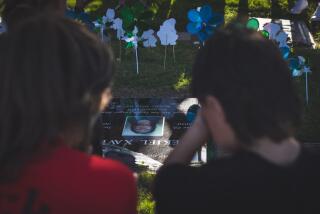Teens See Life After Their ‘Deaths’
- Share via
In March, Chico Police Officer Melody Davidson almost gave up trying to combat the universal recklessness of youth. She was just leaving the apartment of a 21-year-old who had recently died from alcohol poisoning when two of his friends pulled up. On the front seat between the minors lay a memorial marker for their friend--and two open cans of beer. The underage friends were drunk.
“It was everything we were trying to fight,” said Davidson, a member of the alcoholic beverage control unit.
Chico, a mid-sized town with a two-college student population, had a higher than average problem with substance abuse, but young people there are no different from those elsewhere in thinking that they are “invincible and infallible,” Davidson said.
What, she wondered, could possibly get through to these kids? Could they ever be made to understand the finality of death, to see the ripples of pain that their choices might bring their parents, their friends or the workers whose job it is to clean up after them?
Her quest for answers eventually turned into an emotionally jolting, two-day drug prevention program involving the mock deaths of 24 students at two high schools, as well as hundreds of parents, emergency workers and community members. Held in May at a cost of $4,000, the program, called “Every 15 Minutes,” was honored last week by the attorney general’s office with the California Crime Prevention Officers’ Assn. and the office of Criminal Justice Planning.
Davidson said the title derives from national statistics that every 15 minutes someone dies in an alcohol-related traffic collision.
The premise of the program, patterned after a smaller-scale effort in Spokane, Wash., is that kids will change their behavior if they see how much their decisions hurt people they love. “That’s why it was so powerful,” Davidson said. “These kids actually saw what they did to other people.”
Police, school and community members spent five months choreographing the event. They chose 24 student leaders from Chico and Pleasant Valley high schools to play the “living dead.” Their parents signed permits.
Early the first day, a prerecorded heartbeat was broadcast over the public address system. Every 15 minutes after that, an adult dressed as the Grim Reaper in a black hooded cape appeared in classrooms and called out the name of one of the students. After the student left the room with the Grim Reaper, the teacher read a detailed obituary that had been written by the student’s parents.
The students, made up to resemble “the living dead,” returned to class but spoke to no one and did not acknowledge people who spoke to them the rest of the day.
At lunch, a mock collision was staged on campus. Paramedics and police responded with helicopters, the Jaws of Life and ambulances. Students played a trapped passenger who was pronounced “dead” at the hospital and a bicyclist who was pronounced “dead” at the scene and zipped into a body bag.
Meanwhile, police contacted parents at home or at their workplaces to inform them that their child had been in an accident and was either dead or not expected to live. Some went to the hospital and were informed by a surgeon that their child was brain dead and were asked to make a decision regarding organ donation.
One mother, Sherry Payne, said that even though the uniformed police officers reminded her that they were playacting, she lost control when they told her that her 16-year-old daughter, Keri, had gotten into a car with a driver under the influence, was involved in a serious accident and had been killed.
“Tears welled up in my eyes. My stomach turned over. Those words will never leave me,” she said. “All that day my thoughts were about what our life would be like without her.”
To emphasize the idea that they were gone, the “living dead” students spent the night at a retreat where each wrote a letter to their parents that began, “Dear Mom and Dad: Every 15 minutes someone in the United States dies in an alcohol-related traffic collision and today I died. I never got the chance to tell you. . . .”
*
One student, Stacey Carrasco, interviewed in a video documentary of the program, said she had to write two letters because her parents were separated. She and her mother had been estranged, but “being dead” made her realize that “she’s always going to be my mom. You’re only going to have one mom,” she said. “For the first time, I told my mom I loved her and I really meant it.”
As intense as the day had been, school district psychologist Ann Phillippe said the emotional climax occurred the following day at an assembly. The show began with a happy music video of students dancing that cut away to the mock collision. Then, some students read their letters to their parents. The chief of police called on emergency workers and real-life survivors of alcohol-related accidents to come forward.
Said Phillippe: “People the children knew would come forward, people who lost spouses or children. One group after another would be called up, everybody standing united in front of the students sending them the message that said, ‘Your decision affects us personally and we care very much about your life.’ ”
Max Zachai, 17, one of the “living dead” from Chico High, said the second-day program unnerved even those who usually scoff at anti-drug programs like DARE or dramas put on by acting troupes. “I watched them as they watched the video. The crowd went silent. Every face was shocked and scared. It was amazing,” she said.
Last month, a federal study found that teenage drug use nationwide has more than doubled in four years. In Chico, it’s easy for high school students to slip unnoticed into college frat parties, Max said. “I don’t think people even consider alcohol or marijuana an important drug anymore,” she said. “It’s like Pepsi and coffee, just harder to get ahold of.”
She said this program might make people think because it was so different and personal. “It wasn’t somebody from someplace else telling you what you already know, what you’ve heard a million times.”
*
While there’s no way to measure the program’s lasting effect on attitudes or behavior, Phillippe, coordinator of the district’s anti-drug program, said the emotional intensity was stronger than the organizers had anticipated.
“We know when we are emotionally aroused, we tend to remember better, learn better and quicker under those conditions.”
Max said she believed the program was most effective for friends of the “living dead.” Future programs should be broadened to include players from all groups of students, she said.
Some adults question whether such a program would work in larger, urban school districts where violence and firearms are more of a concern than drunk driving.
Phillippe believes “Every 15 Minutes” will work because it “communicated a very strong message to students that your life is precious and we all care very, very much about what happens to you. You’re a valuable person in our community, in our school, in our family. . . .”
It also communicated a strong message to parents, Max said. “Even though those kids drive them crazy, they don’t come home on time, they date people they don’t like, it made them realize how precious they are,” she said.
Chico School District Assistant Superintendent Barbara Conklin, a 29-year veteran of public education, has seen drug prevention programs come and go. “They’re all nice ideas. But this was the idea in all my experience with schools that made the biggest difference I’ve ever seen,” she said.
“Five months later, the parents and kids involved are still coming forward and saying what a difference it makes not just in attitudes toward drugs and alcohol, but the way they interact with one another at home.
“When you change dynamics in a family, you have really made an impact.”
More to Read
Sign up for Essential California
The most important California stories and recommendations in your inbox every morning.
You may occasionally receive promotional content from the Los Angeles Times.













